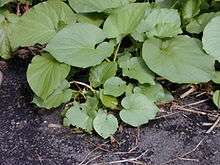Piper auritum
| Hoja santa | |
|---|---|
 | |
| Scientific classification | |
| Kingdom: | Plantae |
| (unranked): | Angiosperms |
| (unranked): | Magnoliids |
| Order: | Piperales |
| Family: | Piperaceae |
| Genus: | Piper |
| Species: | P. auritum |
| Binomial name | |
| Piper auritum Kunth | |
| Synonyms | |
|
Piper sanctum[1] | |
Piper auritum (Hoja santa) is an aromatic herb with a heart-shaped, velvety leaf which grows in tropic Mesoamerica. The name hoja santa means "sacred leaf" in Spanish.[2] It is also known as yerba santa,[3][4] hierba santa,[3] Mexican pepperleaf,[4] acuyo,[4] tlanepa,[4] anisillo,[4] root beer plant,[2] Vera Cruz pepper[5] and sacred pepper.[1]
Description
The leaves can reach up to 30 centimeters (12 in) or more in size. The complex flavor of hoja santa is not so easily described; it has been compared to eucalyptus,[6][7] licorice,[2][8] sassafras,[3][9] anise,[4][10] nutmeg,[4] mint,[11][12] tarragon,[6] and black pepper.[4] The flavor is stronger in the young stems and veins.
It is native to the Americas, from northern South America to Mexico, and is also cultivated in southeast Florida.
Usage
It is often used in Mexican cuisine for tamales, the fish or meat wrapped in fragrant leaves for cooking, and as an essential ingredient in mole verde, the green sauce originated in the Oaxaca region of Mexico.[3] It is also chopped to flavor soups, such as pozole, and eggs.[13] In Central Mexico, it is used to flavor chocolate drinks.[4] In southeastern Mexico, a green liquor called Verdín is made from hoja santa.[14] It is also used for tea. In some regions of Mexico, goat cheese is wrapped with the hoja santa leaves and imbued with its flavor.
While typically used fresh, it is also used in dried form, although drying removes much of the flavor and makes the leaf too brittle to be used as a wrapper.[15]
The essential oils within the leaf are rich in safrole, a substance also found in sassafras, which has been shown to be carcinogenic in animals. In 1960, the U.S. Food and Drug Administration banned sassafras bark along with sassafras oil and safrole as flavoring agents because of their carcinogenic properties[13] and the Council of Europe imposed the same ban in 1974,[16] although toxicological studies show that humans do not process safrole into its carcinogenic metabolite.[17]
Notes
- 1 2 Barlow, Prof. Snow (2003). "Sorting Piper names". University of Melbourne. Retrieved 2007-03-29.
- 1 2 3 Rolland, Jacques L. (2006). The Food Encyclopedia: Over 8,000 Ingredients, Tools, Techniques and People. Robert Rose. p. 326. ISBN 0-7788-0150-0.
- 1 2 3 4 Miller, Mark Charles (1993). Coyote's Pantry: Southwest Seasonings and at Home Flavoring Techniques. Ten Speed Press. p. 70. ISBN 0-89815-494-4.
- 1 2 3 4 5 6 7 8 9 Katzer, Gernot (2012). "Gernot Katzer's Spice Pages - Mexican Pepperleaf (Piper auritum Kunth)". Retrieved 2012-12-03.
- ↑ "Piper auritum". Natural Resources Conservation Service PLANTS Database. USDA. Retrieved 6 October 2015.
- 1 2 "Ingredient - Hoja Santa". The Washington Post. 2004-08-18. Retrieved 2007-03-29.
- ↑ Pyles, Stephan (1999). New Tastes from Texas. Three Rivers Press. p. 214. ISBN 0-609-80497-9.
- ↑ Raichlen, Steven (2000). Steven Raichlen's Healthy Latin Cooking: 200 Sizzling Recipes from Mexico, Cuba, Caribbean, Brazil, and Beyond. Rodale Books. p. 26. ISBN 0-87596-498-2.
- ↑ Lambert, Paula (2000). The Cheese Lover's Cookbook and Guide: Over 150 Recipes with Instructions on How to Buy, Store, and Serve All Your Favorite Cheeses. Simon & Schuster. p. 43. ISBN 0-684-86318-9.
- ↑ Davidson, Alan (1999). The Oxford Companion to Food. Oxford University Press. p. 383. ISBN 0-19-211579-0.
- ↑ Hale, Adrian J.S. (2006-09-28). "Craft, not Kraft, is the key to these homeland treats". Orlando Weekly. Retrieved 2007-03-29.
- ↑ Nordin, Donna (2001). Contemporary Southwest: The Cafe Terra Cotta Cookbook. Ten Speed Press. p. 19. ISBN 1-58008-180-0.
- 1 2 Creasy, Rosalind (2000). The Edible Mexican Garden. Tuttle Publishing. p. 35. ISBN 962-593-297-6.
- ↑ Conner, Lori (2006). "El Restaurante Mexicano (May/June 2006): Beyond margaritas". Maiden Name Press LLC. Retrieved 2007-04-01.
- ↑ Bladholm, Linda (2001). Latin & Caribbean Grocery Stores Demystified. Renaissance Books. p. 106. ISBN 1-58063-212-2.
- ↑ Contis, E.T. (Ed.) (1998). Food Flavors: Formation, Analysis and Packaging Influences (Developments in Food Science). Elsevier. p. 403. ISBN 0-444-82590-8.
- ↑ Benedetti MS, Malnoe A, Broillet AL (Feb 1977). "Absorption, metabolism and excretion of safrole in the rat and man". Toxicology. 7 (1): 69–83. doi:10.1016/0300-483X(77)90039-7. PMID 14422.. "The main urinary metabolite in both species was 1,2-dihydroxy-4-allylbenzene which was excreted in a conjugated form. Small amounts of eugenol or its isomer 1-methoxy-2-hydroxy-4-allylbenzene were also detected in rat and man. 1'-Hydroxysafrole, a proximate carcinogen of safrole, and 3'-hydroxyisosafrole were detected as conjugates in the urine of the rat. However, in these investigations we were unable to demonstrate the presence of the latter metabolites in man."
Also known as Caisimon